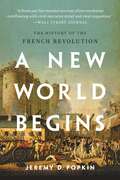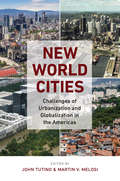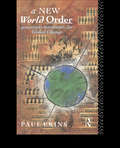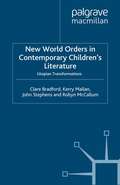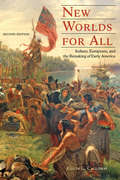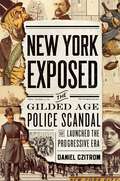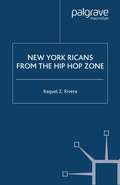- Table View
- List View
The New Work Order: Behind The Language Of The New Capitalism (Studies In Education Ser.)
by James GeeWorkplace democracy. Empowerment. Team leaders. Knowledge workers. This is the language of the new work order promoted by todays management, which promises more meaningful and satisfying work, greater respect for diversity, and more democratic distribution of knowledge.But Gee, Hull, and Lankshear find startling contradictions in this brave new workplaceescalating inequality between individuals, nations, and even continents. They show how newly created alliances between business, educators, and psychologists may point to a hidden capitalist agenda more interested in preserving the status quo than establishing a new work order. This book offers a compelling and controversial account of global capitalism in the information age and the ways it affects language, literacy, learning, and life chances. It will be of particular interest to students in education, business, sociology, sociolinguistics, and communication studies.
A New World Begins: The History of the French Revolution
by Jeremy PopkinFrom an award-winning historian, a magisterial account of the revolution that created the modern worldThe principles of the French Revolution remain the only possible basis for a just society -- even if, after more than two hundred years, they are more contested than ever before. In A New World Begins, Jeremy D. Popkin offers a riveting account of the revolution that puts the reader in the thick of the debates and the violence that led to the overthrow of the monarchy and the establishment of a new society. We meet Mirabeau, Robespierre, and Danton, in all of their brilliance and vengefulness; we witness the failed escape and execution of Louis XVI; we see women demanding equal rights and black slaves wresting freedom from revolutionaries who hesitated to act on their own principles; and we follow the rise of Napoleon out of the ashes of the Reign of Terror. Based on decades of scholarship, A New World Begins will stand as the definitive treatment of the French Revolution.
New World Cities: Challenges of Urbanization and Globalization in the Americas
by John Tutino and Martin V. MelosiFor millennia, urban centers were pivots of power and trade that ruled and linked rural majorities. After 1950, explosive urbanization led to unprecedented urban majorities around the world. That transformation--inextricably tied to rising globalization--changed almost everything for nearly everybody: production, politics, and daily lives. In this book, seven eminent scholars look at the similar but nevertheless divergent courses taken by Mexico City, Rio de Janeiro, Buenos Aires, Montreal, Los Angeles, and Houston in the twentieth century, attending to the challenges of rapid growth, the gains and limits of popular politics, and the profound local effects of a swiftly modernizing, globalizing economy. By exploring the rise of these six cities across five nations, New World Cities investigates the complexities of power and prosperity, difficulty and desperation, while reckoning with the social, cultural, and ethnic dynamics that mark all metropolitan areas.Contributors: Michele Dagenais, Mark Healey, Martin V. Melosi, Bryan McCann, Joseph A. Pratt, George J. Sanchez, and John Tutino.
New World Monkeys: The Evolutionary Odyssey
by Alfred L. RosenbergerA comprehensive account of the origins, evolution, and behavior of South and Central American primatesNew World Monkeys brings to life the beauty of evolution and biodiversity in action among South and Central American primates, who are now at risk. These tree-dwelling rainforest inhabitants display an unparalleled variety in size, shape, hands, feet, tails, brains, locomotion, feeding, social systems, forms of communication, and mating strategies. Primatologist Alfred Rosenberger, one of the foremost experts on these mammals, explains their fascinating adaptations and how they came about.New World Monkeys provides a dramatic picture of the sixteen living genera of New World monkeys and a fossil record that shows that their ancestors have lived in the same ecological niches for up to 20 million years—only to now find themselves imperiled by the extinction crisis. Rosenberger also challenges the argument that these primates originally came to South America from Africa by floating across the Atlantic on a raft of vegetation some 45 million years ago. He explains that they are more likely to have crossed via a land bridge that once connected Western Europe and Canada at a time when many tropical mammals transferred between the northern continents.Based on the most current findings, New World Monkeys offers the first synthesis of decades of fieldwork and laboratory and museum research conducted by hundreds of scientists.
The New World on Mars: What We Can Create on the Red Planet
by Robert Zubrin'A fascinating and enticing vision of the utopian New World that Robert Zubrin believes could and should be created on the Red Planet’ Martin ReesThe world's leading expert on the human settlement of Mars explains what Martian societies will look like - sooner than we thinkWithin a few years, humans will be able to voyage to Mars. SpaceX is at the forefront of companies already building fleets of spaceships to make interplanetary travel as affordable as Old-World passage to America – to the then New World. We will settle the red planet, transforming its raw materials into resources and tackling the challenges that await us, creating a new frontier for humankind.Dr Robert Zubrin explains how populous Martian city-states will emerge, producing their own air, water, food, power and more. How they must be beautiful to attract settlers, and what that might look like. How the primary exports are unlikely to be material goods but intellectual products, created by a technically adept population in a frontier environment where people will be forced to innovate – including GMOs, robotics, AI and power production. Zubrin even predicts the red planet’s customs, social relations and government – of the people, by the people, for the people, with inalienable individual rights – that will overcome traditional forms of oppression to draw talented Earth immigrants.In 1776, Thomas Paine wrote ‘We have it in our power to begin the world over again’. Zubrin inspires us to embrace another magnificent future today. With the right pieces in place, his red planet will become a pressure cooker for invention, benefiting humans on Earth, Mars and beyond. The New World on Mars proves that there is no point killing each other over provinces on Earth when, together, we can create planets.
A New World Order: Grassroots Movements for Global Change
by Paul EkinsFirst published in 1992. Routledge is an imprint of Taylor & Francis, an informa company.
A New World Order: Grassroots Movements for Global Change
by Paul EkinsFirst published in 1992. Routledge is an imprint of Taylor & Francis, an informa company.
New World Orders in Contemporary Children's Literature: Utopian Transformations (Critical Approaches to Children's Literature)
by C. Bradford K. Mallan J. Stephens R. McCallumThis book demonstrates how contemporary children's texts draw on utopian and dystopian tropes in their projections of possible futures. The authors explore the ways in which children's texts respond to social change and global politics. The book argues that children's texts are crucially implicated in shaping the values of their readers.
New Worlds: A Religious History of Latin America
by John LynchThis extraordinary book encompasses the time period from the first Christian evangelists' arrival in Latin America to the dictators of the late twentieth century. With unsurpassed knowledge of Latin American history, John Lynch sets out to explore the reception of Christianity by native peoples and how it influenced their social and religious lives as the centuries passed. As attentive to modern times as to the colonial period, Lynch also explores the extent to which Indian religion and ancestral ways survived within the new Christian culture.The book follows the development of religious culture over time by focusing on peak periods of change: the response of religion to the Enlightenment, the emergence of the Church from the wars of independence, the Romanization of Latin American religion as the papacy overtook the Spanish crown in effective control of the Church, the growing challenge of liberalism and the secular state, and in the twentieth century, military dictators' assaults on human rights. Throughout the narrative, Lynch develops a number of special themes and topics. Among these are the Spanish struggle for justice for Indians, the Church's position on slavery, the concept of popular religion as distinct from official religion, and the development of liberation theology.
New Worlds for All: Indians, Europeans, and the Remaking of Early America (The American Moment)
by Colin G. CallowayAlthough many Americans consider the establishment of the colonies as the birth of this country, in fact early America existed long before the arrival of the Europeans. From coast to coast, Native Americans had created enduring cultures, and the subsequent European invasion remade much of the land and society. In New Worlds for All, Colin G. Calloway explores the unique and vibrant new cultures that Indians and Europeans forged together in early America. The journey toward this hybrid society kept Europeans' and Indians' lives tightly entwined: living, working, worshiping, traveling, and trading together—as well as fearing, avoiding, despising, and killing one another. In some areas, settlers lived in Indian towns, eating Indian food. In the Mohawk Valley of New York, Europeans tattooed their faces; Indians drank tea. A unique American identity emerged.The second edition of New Worlds for All incorporates fifteen years of additional scholarship on Indian-European relations, such as the role of gender, Indian slavery, relationships with African Americans, and new understandings of frontier society.
New Worlds for All: Indians, Europeans, and the Remaking of Early America (The American Moment)
by Colin G. CallowayAlthough many Americans consider the establishment of the colonies as the birth of this country, in fact early America existed long before the arrival of the Europeans. From coast to coast, Native Americans had created enduring cultures, and the subsequent European invasion remade much of the land and society. In New Worlds for All, Colin G. Calloway explores the unique and vibrant new cultures that Indians and Europeans forged together in early America. The journey toward this hybrid society kept Europeans' and Indians' lives tightly entwined: living, working, worshiping, traveling, and trading together—as well as fearing, avoiding, despising, and killing one another. In some areas, settlers lived in Indian towns, eating Indian food. In the Mohawk Valley of New York, Europeans tattooed their faces; Indians drank tea. A unique American identity emerged.The second edition of New Worlds for All incorporates fifteen years of additional scholarship on Indian-European relations, such as the role of gender, Indian slavery, relationships with African Americans, and new understandings of frontier society.
New Worlds From Fragments: Film, Ethnography, And The Representation Of Northwest Coast Cultures
by Rosalind MorrisBringing together the insights of literary criticism, film theory, history, and anthropology, this book explores the tradition of ethnographic film on the Northwest Coast and its relationship to the ethnography of the area. Rosalind Morris takes account of these films, organizing her discussions around a series of detailed readings and viewings tha
New Worlds From Fragments: Film, Ethnography, And The Representation Of Northwest Coast Cultures
by Rosalind MorrisBringing together the insights of literary criticism, film theory, history, and anthropology, this book explores the tradition of ethnographic film on the Northwest Coast and its relationship to the ethnography of the area. Rosalind Morris takes account of these films, organizing her discussions around a series of detailed readings and viewings tha
The New Worlds of Thomas Robert Malthus: Rereading the "Principle of Population"
by Alison Bashford Joyce E. ChaplinThe New Worlds of Thomas Robert Malthus is a sweeping global and intellectual history that radically recasts our understanding of Malthus's Essay on the Principle of Population, the most famous book on population ever written or ever likely to be. Malthus's Essay is also persistently misunderstood. First published anonymously in 1798, the Essay systematically argues that population growth tends to outpace its means of subsistence unless kept in check by factors such as disease, famine, or war, or else by lowering the birth rate through such means as sexual abstinence.Challenging the widely held notion that Malthus's Essay was a product of the British and European context in which it was written, Alison Bashford and Joyce Chaplin demonstrate that it was the new world, as well as the old, that fundamentally shaped Malthus's ideas. They explore what the Atlantic and Pacific new worlds—from the Americas and the Caribbean to New Zealand and Tahiti—meant to Malthus, and how he treated them in his Essay. Bashford and Chaplin reveal how Malthus, long vilified as the scourge of the English poor, drew from his principle of population to conclude that the extermination of native populations by European settlers was unjust.Elegantly written and forcefully argued, The New Worlds of Thomas Robert Malthus relocates Malthus's Essay from the British economic and social context that has dominated its reputation to the colonial and global history that inspired its genesis.
The New Worlds of Thomas Robert Malthus: Rereading the "Principle of Population"
by Alison Bashford Joyce E. ChaplinThe New Worlds of Thomas Robert Malthus is a sweeping global and intellectual history that radically recasts our understanding of Malthus's Essay on the Principle of Population, the most famous book on population ever written or ever likely to be. Malthus's Essay is also persistently misunderstood. First published anonymously in 1798, the Essay systematically argues that population growth tends to outpace its means of subsistence unless kept in check by factors such as disease, famine, or war, or else by lowering the birth rate through such means as sexual abstinence.Challenging the widely held notion that Malthus's Essay was a product of the British and European context in which it was written, Alison Bashford and Joyce Chaplin demonstrate that it was the new world, as well as the old, that fundamentally shaped Malthus's ideas. They explore what the Atlantic and Pacific new worlds—from the Americas and the Caribbean to New Zealand and Tahiti—meant to Malthus, and how he treated them in his Essay. Bashford and Chaplin reveal how Malthus, long vilified as the scourge of the English poor, drew from his principle of population to conclude that the extermination of native populations by European settlers was unjust.Elegantly written and forcefully argued, The New Worlds of Thomas Robert Malthus relocates Malthus's Essay from the British economic and social context that has dominated its reputation to the colonial and global history that inspired its genesis.
New York and Los Angeles: Politics, Society, and Culture--A Comparative View
by David HalleNo two cities are more symbolic of the modern American metropolis than New York and Los Angeles. But while New York boasts a recently revitalized urban center, Los Angeles is the classic example of sprawl and decentralization, with multiple clusters of economic and social activity dispersed throughout its surrounding area. This volume presents advanced studies that consider this fundamental difference between New York and Los Angeles while comparing and contrasting politics and culture in each region. An esteemed group of contributors from a wide variety of disciplines considers issues that include immigration, the effects of race and class on residence, the efficacy of public schools, the value of welfare reform, the meaning of mayoral politics, the function of charter reform, and the respective roles of the cinema and art scenes in each city. Capturing much of what is new and vibrant in urban studies today, New York and Los Angeles will prove to be must reading for scholars in that field, as well as in sociology, political science, and government. Contributors: Andrew Beveridge, Mehdi Bozorgmehr, Geoffrey DeVerteuil, Susan S. Fainstein, Robert Gedeon, Saverio Giovacchini, David L. Gladstone, David Halle, Jack Katz, Karen M. Kaufmann, Rebecca Kim, Mark Levitan, Kevin Rafter, Georges Sabagh, David O. Sears, Heidi Sommer, Raphael J. Sonenshein, András Szántó, Lois Takahashi, Susan Weber, Jennifer Wolch, Julia Wrigley, Min Zhou
New York City and the Hollywood Musical: Dancing in the Streets (Screening Spaces)
by Martha ShearerIn examining the relationship between the spectacular, iconic and vibrant New York of the musical and the off-screen history and geography of the real city—this book explores how the city shaped the genre and equally how the genre shaped representations of the city. Shearer argues that while the musical was for many years a prime vehicle for the idealization of urban density, the transformation New York underwent after World War II constituted a major challenge to its representation. Including analysis of 42nd Street, Swing Time, Cover Girl, On the Town, The Band Wagon, Guys and Dolls, West Side Story and many other classic and little-known musicals—this book is an innovative study of the relationship between cinema and urban space.
The New York City Police Department: The Impact of Its Policies and Practices
by John A. EternoStudying the flagship New York City Police Department is critical to understanding policing and democratic society. An examination of the department by experts who have been studying it for years, The New York City Police Department: The Impact of Its Policies and Practices provides a frank and open discussion about the NYPD from an elite group of
New York Exposed: The Gilded Age Police Scandal that Launched the Progressive Era
by Daniel CzitromOn a Sunday morning in early 1892, Reverend Dr. Charles H. Parkhurst ascended to his pulpit at the Madison Square Presbyterian Church in New York and delivered one of the most explosive sermons in the city's history. Municipal life, he charged, was morally corrupt. Vice was rampant. And the city's police force and its Tammany Hall politicians were"a lying, perjured, rum-soaked, and libidinous lot." Denounced by city and police officials as a self-righteous "blatherskite," Parkhurst resolved to prove his case. The bespectacled minister descended his pulpit and in disguise visited gin joints and brothels, taking notes and gathering evidence. Two years later, his findings forced the New York State Senate to investigate the New York Police Department. The Lexow Committee heard testimony from nearly 700 witnesses, who revealed in shocking-and headline-dominating-detail just how deeply the NYPD was involved in, and benefitted from, the vice economy. Parkhurst's campaign had kick-started the Progressive Movement. New York Exposed offers a narrative history of the first major crusade to clean up Gotham. Daniel Czitrom does full justice to this spellbinding story by telling it within the larger contexts of national politics, poverty, patronage, vote fraud and vote suppression, and police violence. The effort to root out corrupt cops and crooked politicians morphed into something much more profound: a public reckoning over what New York-and the American city-had become since the Civil War. Animated by as vivid a cast as New York has ever produced, the book's key characters include Police Superintendent Thomas Byrnes and Inspector Alexander "Clubber" Williams, the nation's most famous cops, as well as anarchist revolutionary Emma Goldman, the zealous prosecutor John W. Goff, and an array of politicos, immigrant leaders, labor bosses, prostitutes, show-business entrepreneurs, counterfeiters, and reformers and muckrakers determined to change business as usual. New York Exposed offers an unforgettable portrait of a city in a truly transformative moment.
New York Exposed: The Gilded Age Police Scandal that Launched the Progressive Era
by Daniel CzitromOn a Sunday morning in early 1892, Reverend Dr. Charles H. Parkhurst ascended to his pulpit at the Madison Square Presbyterian Church in New York and delivered one of the most explosive sermons in the city's history. Municipal life, he charged, was morally corrupt. Vice was rampant. And the city's police force and its Tammany Hall politicians were"a lying, perjured, rum-soaked, and libidinous lot." Denounced by city and police officials as a self-righteous "blatherskite," Parkhurst resolved to prove his case. The bespectacled minister descended his pulpit and in disguise visited gin joints and brothels, taking notes and gathering evidence. Two years later, his findings forced the New York State Senate to investigate the New York Police Department. The Lexow Committee heard testimony from nearly 700 witnesses, who revealed in shocking-and headline-dominating-detail just how deeply the NYPD was involved in, and benefitted from, the vice economy. Parkhurst's campaign had kick-started the Progressive Movement. New York Exposed offers a narrative history of the first major crusade to clean up Gotham. Daniel Czitrom does full justice to this spellbinding story by telling it within the larger contexts of national politics, poverty, patronage, vote fraud and vote suppression, and police violence. The effort to root out corrupt cops and crooked politicians morphed into something much more profound: a public reckoning over what New York-and the American city-had become since the Civil War. Animated by as vivid a cast as New York has ever produced, the book's key characters include Police Superintendent Thomas Byrnes and Inspector Alexander "Clubber" Williams, the nation's most famous cops, as well as anarchist revolutionary Emma Goldman, the zealous prosecutor John W. Goff, and an array of politicos, immigrant leaders, labor bosses, prostitutes, show-business entrepreneurs, counterfeiters, and reformers and muckrakers determined to change business as usual. New York Exposed offers an unforgettable portrait of a city in a truly transformative moment.
New York Hotel Experience: Cultural and Societal Impacts of an American Invention (American Culture Studies #19)
by Annabella FickFor more than two hundred years hotels have played a significant role in American history. The modern hotel is even an American invention. In five case studies of iconic New York hotels, this book presents the hotel experience of the white upper class, literati, young artists, African Americans and Jewish Americans in the twentieth century. Using a variety of texts, including autobiographies, movies and novels, the impact of hotel experience on society and culture - which has been neglected until now - becomes apparent. This unique approach offers a new way of reading New York and helps to better understand the city's special dynamics.
New York Neighborhoods - Addressing Sustainable City Principles
by Raymond Charles RauscherThis book examines the neighborhoods of New York City to determine to what extent planning in New York addresses Sustainable City Principles (SCPs). Part I looks at the background to planning urban areas in the face of global urban changes. These changes (i.e. population movements and densification of cities) are placing pressures on cities worldwide. Chapter 1 provides a background to these global pressures (i.e. population growth) and their implications. Chapter 2 looks closer at New York planning and introduces Sustainable City Principles (SCPs). Part II introduces nine selected neighborhoods within Manhattan and examines to what extent planning of these neighborhoods addresses the SCPs. For each chapter a neighborhood background is provided and results of the author’s field survey are reviewed. Part III examines the selected neighborhoods within Brooklyn to determine to what extent planning of those neighborhoods addresses the SCPs. Part IV examines the last three neighborhoods (in Queens) and addresses the SCPs. Part V examines conclusions reached from examining the nine neighborhoods. These conclusions are used to determine the extent that the City Council (and the community) are addressing SCPs in planning neighborhoods. Finally, lessons learned from these conclusions are assessed for their relevance to planning neighborhoods anywhere in the world.
New York New Wave: The Legacy of Feminist Art in Emerging Practice (International Library of Modern and Contemporary Art)
by Kathy BattistaNew York is a centre of creative production for an exciting, emerging generation of women artists. Their work investigates themes such as the body as medium and subject matter; the deconstruction of the existing patriarchal order of the art world; the appropriation of earlier art historical references; and the use of so-called abject and everyday materials. New York New Wave investigates the relevance of earlier feminist practice for this 'new' generation, asking: Does gender difference still play a role in today's practice? How can younger women artists embrace a radical political ideology and yet remain market friendly? How far have these artists diverged from the established feminist "tradition"? Artists discussed include: Firelei Baez, EV Day, Ruby LaToya Fraser, Diana Al-Hadid, K8 Hardy, Valerie Hegarty, Cindy Hinant, Dawn Kasper, Anya Kielar, Liz Magic Laser, Narcissister, Alix Pearlstein, Aurel Schmidt, AL Steiner and W.A.G.E.
New York New Wave: The Legacy of Feminist Art in Emerging Practice (International Library of Modern and Contemporary Art)
by Kathy BattistaNew York is a centre of creative production for an exciting, emerging generation of women artists. Their work investigates themes such as the body as medium and subject matter; the deconstruction of the existing patriarchal order of the art world; the appropriation of earlier art historical references; and the use of so-called abject and everyday materials. New York New Wave investigates the relevance of earlier feminist practice for this 'new' generation, asking: Does gender difference still play a role in today's practice? How can younger women artists embrace a radical political ideology and yet remain market friendly? How far have these artists diverged from the established feminist "tradition"? Artists discussed include: Firelei Baez, EV Day, Ruby LaToya Fraser, Diana Al-Hadid, K8 Hardy, Valerie Hegarty, Cindy Hinant, Dawn Kasper, Anya Kielar, Liz Magic Laser, Narcissister, Alix Pearlstein, Aurel Schmidt, AL Steiner and W.A.G.E.
New York Ricans from the Hip Hop Zone (New Directions in Latino American Cultures)
by R. RiveraNew York Puerto Ricans have been an integral part of hip hop culture since day one: from 1970s pioneers like Rock Steady Crew's Jo-Jo, to recent rap mega-stars Big Punisher (R.I.P.) and Angie Martinez. Yet, Puerto Rican participation and contributions to hip hop have often been downplayed and even completely ignored. And when their presence has been acknowledged, it has frequently been misinterpreted as a defection from Puerto Rican culture and identity, into the African American camp. But nothing could be further from the truth. Through hip hop, Puerto Ricans have simply stretched the boundaries of Puerto Ricanness and latinidad.

